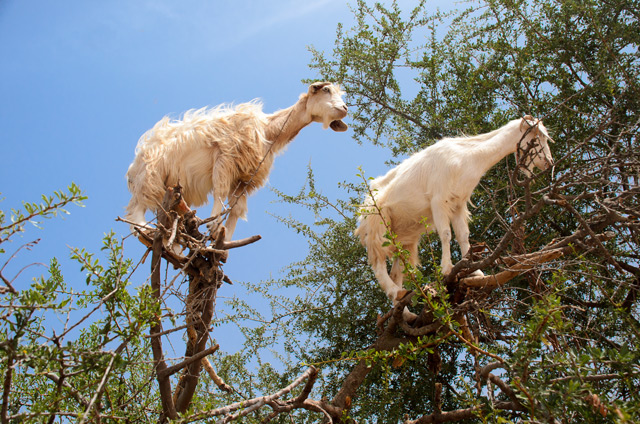
This behavior has made goats a part of both the argan forest's ecosystem, and the local community's economy. After chewing on the argan fruit, the goats spit out the fruit's acorn-sized seed, or sometimes defecate it if they can. When they spit it out, the goats become part of a seed dispersal process that helps grow new trees in the area, according to a study published in Frontiers in Ecology and the Environment. Researchers found that because seeds sometimes remain in the goats' stomach for days before they spit it out, some seeds are dispersed at a distance from their mother plant, giving them a better chance for survival.
At the same time, by spitting out or defecating seeds from the argan fruit, the tree-climbing goats help farmers produce argan oil -- the luxurious substance used in beauty products and health treatments alike. The oil is a main source of livelihood for local communities that produce it. It is handmade by local North African Berber women following a notoriously tedious process that has been in place since ancient times. The process yields only one liter of argan oil for two days worth of work.
Goats have been part of the argan oil production line for years, as they are able to harvest the argan fruit with ease -- better than farmers can. Also, according to EssenceofArgan.com, their stomachs help pre-process the nut by softening the tough outer shell, making it easier to crack the nut and get to the pulp inside.
Some argue, however, that these tree-climbing goats do more harm than good. Biologist and ecologist Jose Fedriani, one of the authors of the seed dispersal study, said that a surplus of goats prevent the argan forest from flourishing as they end up eating young argan trees even before they grow. In an interview on NPR.org, Fedriani implied that the goat population in argan forests must be kept in check, saying "We need to have a balance between the number of goats and number of trees and try to keep the equilibrium."
Will climb walls for food
At any rate, goats have proven to be dedicated foragers -- turning to extreme measures in pursuit of sustenance. Perhaps even more impressive than Morocco's tree-climbers are the ibexes that have been seen making death-defying, near-vertical ascents all for a lick of salt. The ibex is a species of wild goat often found in mountainous areas, such as The Alps.
A video by the BBC shows a female ibex casually scaling the wall of the Cigno dam in northern Italy, with her young trailing behind her. The wall is over 100 feet tall, and the video shows the animals climbing it at a considerable height, a feat made even more impressive considering the wall has only a few small crevices from where the animals can perch. Their ascent is made possible by their pincer-like hooves, which enable them to cling on to the wall.
https://youtu.be/z2YKwGtcMY8
According to the video, the ibexes do the risky climb to get to the mineral deposits on the dam's wall. The animals subsist on a vegetarian diet, and need the minerals on the wall for their bones to grow and their nerves and muscles to function.
https://youtu.be/RG9TMn1FJzc
This only goes to show that when it comes to getting their food and nutrition, goats are pretty much unstoppable.
Get more stories like this on WeirdScienceNews.com.
Sources include:
YouTube.com 1 YouTube.com 2 OnlineLibrary.Wiley.com EssenceofArgan.com NPR.org
Please contact us for more information.




















